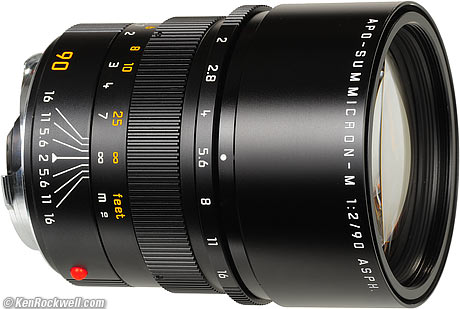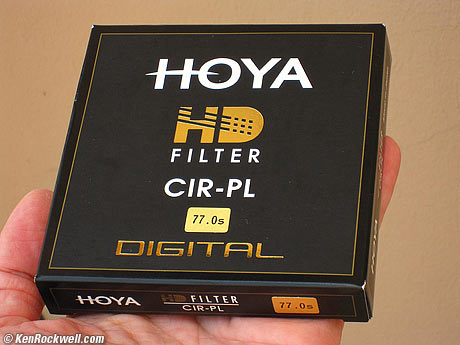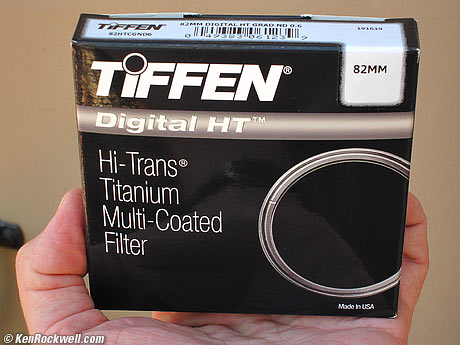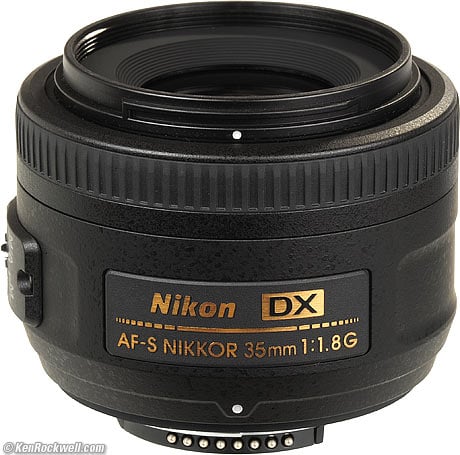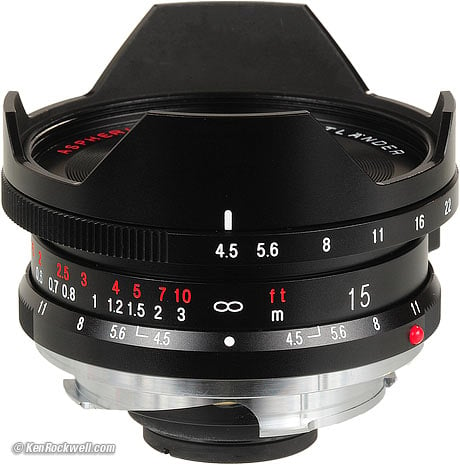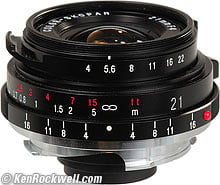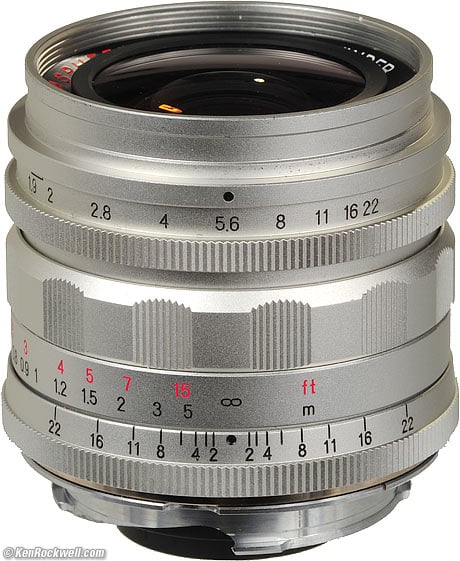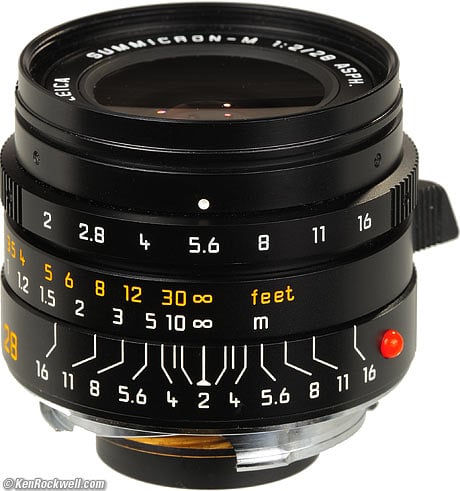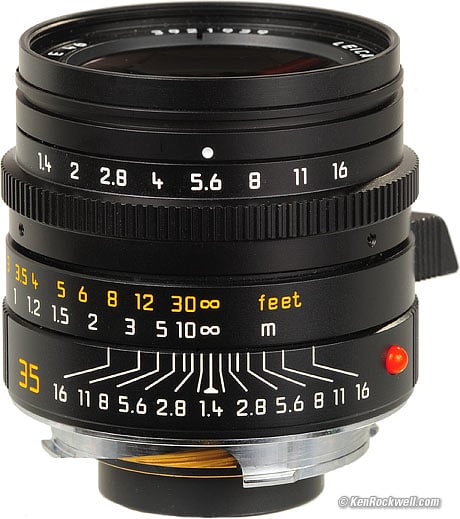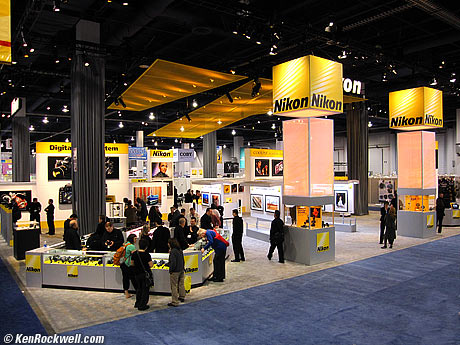Home Search Gallery How-To Books Links Workshops About Contact
March 2009's
Updates RSS
all © 2009 KenRockwell.com. All rights
reserved.
|
I personally buy from Adorama, Amazon, Ritz, B&H, Calumet and J&R. I can't vouch for ads below.
|
31 March 2009, Tuesday
NEW: The Two-Pocket Shuffle. My favorite way to shoot. My favorite bag is no bag at all if I can.
How Sick is Rockwell?
Is it just me, or I wonder if others are as crazy as I am.
I'm more excited right now about heading out to The Flower Fields (after I drop my other film at NCPS) to try shooting a 35mm fixed-lens Chinon Auto 2001 point-and-shoot from 1986, that I just bought for $3.50 at a thrift store, than I am about shooting some of the ultra-expensive Leica gear that's wandered in here for review.
It's probably because its more fun to try to make great images on crappy gear than it is to use great gear.
It's also the treasure-hunt aspect: we know Leica lenses are going to be great. Big deal. I have no idea what I'll get from the Chinon. If I get anything, I'm going to be totally stoked, as if I just found the treasure!
I think I'll try print film, and if it passes, then try slides. Exposure can be a few stops off with print film and still look great. It takes a better camera (like a great point-and-shoot or an SLR) and a knowledgeable photographer to get decent results with slides, because your exposure has no room for error because what you see is exactly what you shot.
Lowe-Pro
I wasn't dumping on Lowe-Pro or anyone in particular last week with my crack below.
I was dumping on my confusion with why everyone I see as a newcomer to the hobby of photography is out in the field wrestling with a 50-pound (25kg) backpack of brand-new gear on their shoulders.
Why would anyone want a bag that doesn't let you get your gear unless you set it down first? That's stupid; you may as well leave it in its boxes at home.
It's always OK to buy and own every possible camera, lens and accessory, but its never OK to take it all with you at one time.
I try never to take more than two extra lenses with me, anywhere.
How do I prefer to shoot in the field? With the Two-Pocket Shuffle.
27 March 2009, Friday
New: I just got hold of a Think Tank Speed Demon camera bag.
I think it might be the bag for which I've been searching for traveling smart, which means light.
I've not been able to find practical bags lately, since most bags today are dominated by the (I think) foolish backpack design for people who carry too much and don't shoot very often.
For those of us who travel light and want to get to our stuff instantly (without having to put a backpack down in the mud or strangle ourselves spinning it around), this new waist pack may be perfect.
The Speed Demon even has an integral, removable tethered rain cover and an integral, removable tethered 10-place memory card holder.
I'm especially stoked about the tethered card holder: I'll use it to hold my 39mm filters! It can hold up to 46mm filters if you really jam them in, but 39mm filters are perfect.
You probably haven't heard of Think Tank, but the pros have. Think Tank have only been around a few years. While Lowe-Pro is popular with people who don't shoot much, the pros I know have been bragging to me for the past couple of years about how great their Think Tank belt systems are.
Now that I've got one of Think Tank's small bags, Ill let you know how it works. So far, it looks brilliant, loaded with easy-pull zippers and pockets all over to hold everything.
Leica 90mm f/2 ASPH.
NEW: Leica 90mm f/2 APO-Summicron-M ASPH Review. The world's highest performance telephoto lens, for the Leicaman.
Toad Suck Daze: And least we forget, don't forget Toad Suck Daze 2009, May 1st - 3rd in downtown Conway, Arkansas.
25 March 2009, Wednesday
Coming Soon: Save the Frogs Day, April 28th 2009.
While we're at it, some other groups to which I and everyone else should belong are the:
These guys work towards helping nature and wildlife do its thing, without which, we'd all have a lot fewer things to photograph.
Even if you never get outdoors, the NWF's magazine is loaded with the best photography you'll see, and their annual photo contest is loaded with the most extraordinary nature and wildlife photography I see each year.
Contrary to what the name might suggest, this isn't a surfing club. The Surfrider Foundation works to keep our beaches and oceans clean, without which we'd also lose most of my favorite places to photograph.
I've met many of these folks locally here in San Diego, and they are the best bunch of people you might ever hope to meet. Many, and maybe most, of the people who work in the Surfrider Foundation donate their professional hours towards the work of the foundation. When I donate to them, I know I'm getting my money's worth towards keeping our littoral zones clean for photography.
Funny thing about the word "littoral" is that it refers to what I think is the most beautiful part of the Earth, and the only people who seem to use this word are the military in reference to combat areas and equipment.
24 March 2009, Tuesday
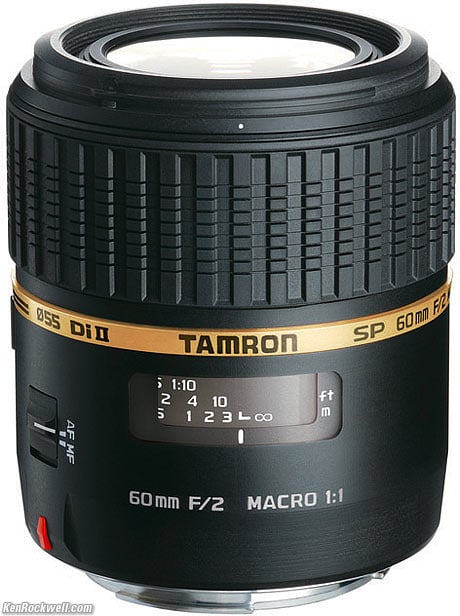
Tamron 60mm Macro.
Tamron 60mm f/2 Macro - Not Quite Yet
Tamron announced today the development of a 60mm f/2 macro. This means we can't buy it today, but ought to in a year.
It can't cover film, FX or full-frame. It only covers half-frame digital like the Canon 1.6x and Nikon DX cameras.
It goes to 1:1 life-size on-sensor.
It will have to compete against Nikon's superb 60mm f/2.8 AF-S Micro, which covers FX and film, and Canon's excellent 60mm f/2.8 Macro, both of which are available today.
California Central Coast Readers:
I need to get up to Santa Barbara and/or San Luis Obispo to enjoy all the spring flowers.
I ask of you folks who are lucky enough to live there: are they peaking now, or should I come back in April?
Thanks! Ken.
Hoya HD Polarizer.
NEW: Hoya HD Filters. These filters set the new standard for polarizing filters. They really are much better than other polarizing filters.
Tiffen HT Grad Filter.
NEW: Tiffen HT Filters. These filters set the standard in neutral-density graduated filters, one of the two filters I carry everywhere for shooting digital.
23 March 2009, Monday
Fuji Reala 100
Rununculous. Original scan from CD.
My pal David Lang shot this on his old manual-focus Nikon and Fuji Reala 100. He dropped it off at Price Club (Costco) and got this back on CD. It looks great to me!
Fuji Velvia 50 is a tough professional film to shoot well; there is no margin for error in exposure. Reala is a color negative film, meaning you can get it processed anywhere. It's my favorite color negative film. (I've tried Kodak's Ektar 100, and haven't liked it.)
If you have your film processed and scanned at Price Club, but don't ask for prints, the whole job only runs about $5.
Rockwell Screws-off
Ryan at Legoland.
I took Ryan to Legoland and offer these snaps.
What's telling is that I grabbed my lightweight D40 as usual, not my D3 or D300.
Why?
Simple: why would I want to haul around a heavy camera, when the D40 works as well, and even better than the big cameras for use with fill flash?
Because of the D40's superior 1/500 sync speed, I can use my tiny Nikon SB-400 flash instead of needing the extra power of the much heavier SB-600.
I also found an internet source for the Roscoe 1/2 CTO warming (orange) gel I tape over the flash to give nice, warm fill light instead of the usual bluish light I'd get from naked flash. Just as I expected, Adorama will sell you huge sheets of this filter material for $7 a sheet.
I used to have to go downtown to the stage lighting store to buy it. I'm still using the same sheet I bought 10 years ago, one little piece at a time.
I also grabbed my all-plastic Nikon 55-200mm VR lens, since I hadn't used it in a while. For $220, it's a fantastic lens and weighs nothing. I have no idea why some people try to spend so much money just to get cameras so heavy that they never want to take them out and shoot them.
If I had hauled a D3 and 70-200mm f/2.8 pro zoom, it would have weighed a ton, and still not allowed me to get as close when zoomed into 200mm as opposed to the resolution of the D40 at 200mm, since the D40 has a higher pixel density than the D700 or D3. Yes, the plastic 55-200mm zoom lets me crop better (get closer) than with the pro lens and pro camera. Ha ha!
I also brought my Canon 110ED. I found Kodak 400 film in 110 size at Wal-Mart, and Wal-Mart will develop, print and scan 110 film, too. Who hoo, maybe I can upgrade to 110 film from 35mm. We'll see; I haven't finished the roll yet. Wal-Mart has only the professional 24-exposure loads, not the 12-exposure rolls I was expecting.
22 March 2009, Sunday
Nikon 35mm f/1.8
Added a section on Spherochromatism.
The Nikon D3X Boycott is Working
Our boycott is working.
Nikon Europe just started to offer a €500 rebate on the Nikon D3X.
I won't budge until it comes in under $5,000 USD, its current actual market value.
Even at $5,000, I don't know that I'd want a D3X. Since Nikon dared to ask such a ridiculous price at its December 2008 announcement, I researched and went back to film, and I doubt I'm going to waste any more money on digital for careful nature and landscape shooting. "Careful" means the sorts of things most people shoot from tripods or as raw files.
Sure, I love digital for action, low-light and kids (I shot 300 pictures yesterday with my D40 and new Nikon 35mm f/1.8 lens of my son playing), but for quality, I thank Nikon for asking so much for the D3X that I looked into the inexpensive (by comparison) Leica cameras instead, and chose to go with them.
Since the D700 gives the same quality for 99% of what I do, and the D90 gives the same quality for 90% of what I do, why would I need a D3X, even at $5,000? When I really want quality, I shoot film.
Another reason I love digital is because it has lowered our standards so much that even 35mm film today looks spectacular by comparison. I used to carry a 4x5" camera everywhere, and shot 2-¼" when I wanted to travel light.
With digital setting everyone's expectations so low, I can get away with a super-light and easy-to-use 35mm camera, and get the same sharpness I'd get with the D3X, but with better color.
Thank you Nikon!
20 March 2009, Friday
Wonders of Baja: My pal Jim Cline has a couple of openings on his next Baja trip. Check it out! Jim's tours are awesome.
Nikon 35mm f/1.8.
NEW: Nikon 35mm f/1.8 AF-S Review.
and sort of new: Nikon 35mm f/1.8 Example Photos and Nikon 35mm f/1.8 Comparisons.
Is the Nikon D400 coming on March 25th?
Nikon D90 user guide in PDF: I might have one next week for you folks, yippee!
Do you folks want me to do a guide for the Canon 5D Mark II? The coolest thing about the 5D Mark II is that you can turn on a "quick adjust" screen or something like it, which lets you set everything from the rear LCD using the thumb nubbin and rear wheel. This makes the 5D Mk II a zillion times easier and faster to use than anything ever from Canon.
T90? I have one, and hope to review it one of these days. It may have been the best camera ever made by Canon. I still need to digest the instructions.
DigLloyd reviews the Mac Mini and the new Mac Pro.
Busted at PMA: I'm shown in a PR photo.
New 15mm lens:
Voigtlander 15mm f/4.5 for Leica M: takes 52mm filters.
Rule #3 in Business: Any deal, business, scheme or transaction that takes more than 60 seconds to explain is a scam.
The cold-calls I got from Monarch Productions in Los Angeles earlier this week trying to get me to invest in movie deals did turn out to be a scam, and the way I saved myself from losing hundreds of thousands of dollars saw simply that the red light in the back of my head went off when the salesman tried to get me to watch a 30-minute online presentation, and couldn't explain it more simply when I asked him to. "Hollywood is different" he claimed, but I worked in Hollywood, and the basics are the same as everywhere.
19 March 2009, Thursday
Voigtländer 21mm f/4 (actual size).
NEW: Voigtländer 21mm f/4 Review.
110 film cartridges of 1970s were a downgrade from 126 Instamatic film of the 1960s.
110 was another plot by Kodak to sell less film for more money, just as was the APS scam of the 1990s.
110 film, named after the road that runs past Nikon USA's headquarters, was a film format so small that no one ever got a sharp photo on it.
Last night I popped into a thrift store, and in their 50% off bin was a complete Canon 110ED outfit, complete with manuals, Canon Canolite ED flash and dedicated Canon Speedlite extender. Not bad at all for $10, and even better at $5 after 50% off!
As I'm sure you all remember, the Canon 110ED is the premium model with the 5-element f/2 lens and coupled rangefinder, fully automatic exposure, hot shoe, cable release and tripod sockets and adjustable apertures. (By comparison, the Canon 110E was the ordinary model with a scale-focus f/2.7 lens.)
The Canon 110ED even has date imprinting. Of course you have to set the date manually with thumb wheels, and it only sets from 1977 ~ 1986, showing us that even Canon knew the format didn't even have a 9-year life. You also can set the year to any of 0 ~ 9, meaning I can set it to 19-3-9 for today.
Do any of you folks have any idea where I can get 110 film printed or scanned to CD? My local lab can process the film, but has no easy way to print or scan it other than on a flatbed scanner.
Not only did I get the camera, manuals and all accessories for my $5, the flash and camera also came with what my ZTS tester tells me are brand-new batteries. Weird but cool!
Poke all the fun you want of 110 (I know I sure have), but it's the exact same size as the four-thirds sensor: 13 x 17mm!
As I recall, my dad bought one of these back in the 1970s, and the results were so bad he got rid of it. It's a great camera, but crippled by the format. Now if someone hooks a 4:3 system sensor into it, we have one heck of a camera.
18 March 2009, Wednesday
Nikon 35mm f/1.8
I got my new $199.95 Nikon 35mm f/1.8 yesterday, and am writing it up.
As expected, it's great. It's super-duper sharp, focuses perfectly, but does have some easy-to-correct barrel distortion.
If you shoot it on a Gen 1 camera like the D40, it has some green-magenta lateral color fringes, but it's perfect on a Gen 2 camera like the D90 and D300.
It won't work full-frame, but it ought to work on the APS Nikon Pronea-S. It looks OK through the finder, but only covers a 40mm image circle (cuts off all four corners) at shooting aperture.
More to come; for now, you can look at Ryan playing in the park, shot half an hour ago.
I also remembered how much I hate shooting with digital cameras.
I pick up my D40, and the flash for some reason is set to full-power manual. It took me until after lunch until I could get left alone for a few minutes to get into the menus, turn the FULL menus back on, find the correct CFN, and reset the flash back to TTL where it belongs.
On a real camera, you never get stuck in the menus like this: you just shoot.
By the time I figured out how to get my flash back to normal, the Leicaman already had shot three perfect rolls.
On a real camera, the instruction manual is only 10 pages long; just enough to show how to load the film, focus and shoot.
Sure, I wrote the book on the D40, and even I get stuck.
Wouldn't it be so much better if we didn't need 279-page books just to figure out how to get the camera to take a picture? Cameras should just go.
Where's my QuickSnap?
Rip-Off Rockwell Week
What is it this week?
Last week I ordered $70 worth of Leica lens caps from some guy in Taiwan over eBay, and they turned out to be counterfeits worth only about $3. eBay refunded my money and I forwarded the contraband to Leica USA, to send to Germany for prosecution.
Yesterday I get a call from some guy in LA trying to get me to invest in his movie-making deal. I was going to listen to his pitch, but he couldn't explain it in any less than 30 minutes.
As everyone in business knows, any deal that can't be explained in less than one minute is a scam, and lo and behold, as I had this guy on the phone, I found the Desist and Refrain order against them for trying to sell investments without the correct whatever. I have a sneaking suspicion that this order was telling them to stop doing exactly what they were doing, which was cold-calling me and promising me "tripling my money in two years, guaranteed."
Geesh, everyone's trying to rip me off this week, not just the camera companies as usual.
17 March 2009, St. Patrick's Day
Voigtländer 28mm f/1.9.
NEW: Voigtländer 28mm f/1.9 Review.
NEW: The Leica Man.
Leica 28mm f/2 ASPH
NEW: Leica 28mm f/2 ASPH Review.
Leica 35mm f/1.4
NEW: Leica 35mm f/1.4 ASPH Review.
Happy St. Patrick's Day!
And an especially happy St. Patrick's Day to everyone at UCSB and UCLA.
12 March 2009, Thursday
Nothing New?
N David King asked me if I really meant it when I said there was nothing particularly new or exciting at PMA 2009 (full coverage).
Sadly, yes, there wasn't anything that interesting, other than a few new lenses from Canon, Leica and Nikon. Lenses have advanced, and I get off on that, but cameras haven't advanced in any earth-shattering way.
Up until about 1997, cameras got smarter and added more clever features to help us make better photos every year. Since 1999 when the first practical DSLR came out (the Nikon D1), cameras themselves haven't advanced; it's just been the digital features and firmware inside those cameras that get smarter.
The cameras themselves that support the digital guts inside haven't leaned anything epoch-making in over 10 years.
We old-timers used to complain about silly new features that "real photographers" didn't need, like coupled rangefinders (1950s), SLRs (1960s), TTL meters (1970s), program and auto exposure (1980s), Photoshop (1990s) and digital capture (2000s). Even the crankiest of us eventually realized that these help us make better pictures because we could spend more time concentrating on composition, and complain as we might, we came to need each of them. (Of course I still whine about Photoshop and digital capture, but that's because I'm 15 years behind the times).
The problem today is that the basic design of an SLR hasn't advanced since Nikon's F5 of 1996. Nikon's best of today, the D3, D700 and everything else Nikon makes, still work basically the same way. The controls are in the same places and do the same things. No one has figured out a smarter way, and honestly, I still prefer having dedicated shutter speed, aperture, ISO and exposure mode dials like on the indomitable Nikon F4 of 1988, or earlier cameras, or today's Leica rangefinders.
All the design smarts of the past decade have been invested into making digital work and work better, but not to improve the overall operation and ergonomics of the cameras themselves. The biggest innovation has been Nikon's perfection of autofocus as of the D3, in which a sea of AF sensors works perfectly while clearing the focus screen of the clutter of earlier cameras.
11 March 2009, Wednesday
Nikon 35mm f/1.8 Now Shipping
The Nikon 35mm f/1.8 has started shipping today to the people who've had them on order.
As soon as I get mine, you'll know all, but hey, for $200, I know I'm going to love it.
D40 replacement?
Well, nothing came out at PMA 2009, which is a good thing, because the Nikon D40 is a spectacular camera that whups every other Nikon (and other brand) DSLR at many important things, like weight, price and flash sync speed.
The D40 has been out since Christmas 2006 and is the oldest digital SLR in Nikon's book, so it is due for replacement.
Sources in the Orient tell me that the D40 has been vanishing from store shelves, and that there is a trade show in Tokyo on March 26th, so who knows?
Ritz
Some have asked if I'm concerned that Ritz Camera Centers, the retail stores, filed for chapter 11 debt restructuring.
No, since I do all my buying online, and it just happens that RitzCamera.com is actually a completely separate business with different owners than the retail stores.
New Macs
The New Mac Pros and Mac Minis are loaded with Firewire 800 ports for pro use.
The Mac Pro has four FW800 ports, and the new iMac and Mac Mini each have one FW800 port, which is all I need.
DigLloyd pointed out that even the Mac Mini today might do what I need, since my biggest concerns for wanting to replace my 2006 Quad G5 is because it takes 15 seconds to wake from sleep and makes too much fan noise.
Heck, I didn't realize it, but the $599 Mac Mini can drive my 30" display and do just about everything I need, although if the Mac Pro is silent, I'm going for one of them for the 1TB HDD.
We'll see; the world is awaiting DigiLloyd's review of the new Mac Pro.
Carlsbad's Flower Fields
I lived in San Diego for about ten years before I figured out how to find the huge flower fields right off the I-5 freeway in Carlsbad, about 45 minutes north of San Diego.
I felt like a real fool when I discovered that you can see them as you drive by on the freeway, and always have!
They are in bloom again, so pop by, pay the $10, and have the time of your life photographing a gazillion flowers.
Note: like all private property, you may not use any photos you make of their flowers for any commercial purpose without getting a property release first. They expect you take lots of pictures, but don't expect to use them as a free location for commercial photography or use their flowers for your own stock or other photography.
If you're local, splurge $20 and get a season's pass.
Photo Books
I haven't tried them, but Adorama's Lab now also makes photo books.
Reset all your camera clocks
I almost forgot to remind everyone: be sure to go and set all your digital camera clocks to DST.
They don't set themselves (except the iPhone), and if you don't make a point of finding and resetting every digital camera you own, it might not be until September that you notice that your clock is an hour off.
DxOMark
DxOMark has added the Sony A700, A300 and A200 cameras to their sensor performance database.
The USA's National Wildlife Federation's 2009 photo contest is up and running. You've got until 20 July 2009 (Monday) to enter.
It's nearly free to enter, and could pay you $5,000.
Yes, it costs a whopping $15 to enter 20 photos, but that $15 gets you a one-year NWF membership and subscription to the extraordinary National Wildlife magazine, which is loaded with great photos in each issue. I think I pay much more just for my annual membership, so even if you don't have any photos to enter, You'll want to pretend just to get the subscription for a year for the $15.
If the date sounds familiar, that's because it's the 40th anniversary of Man's greatest achievement: landing men on the moon and returning them safely to Earth. It's the proudest day in American, and Mankind's, history.
Polarizing Filters and Dog Urine
I'd read that polarizing filters are derived from dog urine, so I decided to look it up.
Lo and behold, Dr. Edwin H. Land, who later went on to invent Polaroid and SX-70 film, really did invent the world's first sheets of polarizing material in the 1940s. They were based on crystals precipitated out of dog urine. You fed the dogs quinine and put some iodine in the pee, and voila!, tiny polarizing crystals.
You can read all about it here.
Something I didn't realize is that as America brought freedom to the South Pacific in WWII, quinine became hard to get because it was needed to combat malaria.
The brilliant Dr. Land, also a great friend of Ansel Adams, then invented a completely new way to make sheets of polarizing material that didn't need quinine.
Even if you don't use polarizers in your photography, they are everywhere. Of course they are in your camera's AF system, but the most important use is in every LCD screen, of which most cameras have three (the big one on the back, the little one on the top, and in the finder to make the numbers).
The monitor on which you're reading this page works with a big sheet of polarizing material, and so does your LCD TV and LCD watch. If you think I'm kidding, look at any of these through a polarizing filter, and if you rotate it, you can make the screen go black!
09 March 2009, Monday
Film Reality
A reader was concerned that he couldn't find film or processing locally, as if this was some sort of new issue.
Although we expect color print film and 1-hour processing on every street corner, I haven't bought my film locally for over 30 years!
To buy whatever film I want at the right price, I've bought it mail-order from B&H and Adorama since 1975! My local store never had exactly what I wanted even back then.
Unlike digital, where everything is pretty much the same and therefore easy to find, film comes in so many types, sizes and packaging that you'll rarely find what you want at retail, and never at the right price if you do.
Even if you only shoot Velvia, you'll see over two-dozen different items at each link above. Multiply that by the zillion kinds of film, and you'll see why no store other than B&H and Adorama are ever likely to have what you want by walking in.
Back in the 1970s and 1980s I shot Kodachrome, which I mailed to Kodak's labs in New Jersey or Hollywood for processing. There never was local processing for Kodachrome, and still isn't, unless you're in Parsons, Kansas.
In 1990 when I started to shoot Fuji Velvia (E-6), I first used Fuji processing mailers because I could get them cheap. Even today, you can get them for $5 each at B&H. They don't include the direct-to-digital scanning I get at NCPS, but we all can get pro-level film and processing as close as our mailboxes as I did for decades.
It's only been recently that I've bothered with retail processing, because I like to see what I've shoot immediately as I'm reviewing a camera or lens.
If you're not in a rush, it's a lot easier and cheaper to do it by mail. If I lived in another city, I could mail my film to NCPS, with scanning, just the same.
Heck, If I wasn't always so curious to see what I shot, even living close to NCPS, I still think I'd save a lot of drive-time mailing them my stuff.
Postage costs a lot less than car expenses, even if you live only several miles away and even if you consider your drive-time of no value.
See more lab suggestions at my Photo Labs page.
07 March 2009, Saturday

The Rockwell Dogs, Christmas Card 2005.
R.I.P.: Megan Rockwell
Our cutest Shitzu-poo, Megan, passed away last night. A short tribute is at Ryan's website.
06 March 2009, Friday
Nikon's Booth at PMA 2009.
NEW: PMA 2009 Report.
Here's someone else who sees the same thing: real photographers are coming back to film in droves. Most of us have finally tired of throwing money away at digital, and prefer the better results from film for photos that matter.
Why film all of a sudden? Because unlike 2002 when we all went digital, today it's trivial to get great digital files directly from film as we shoot it, for a lot less money with a lot less hassle than hauling all the laptops and chargers and cords and blank DVDs and everything else digital cameras need to keep them running in the field.
The only reason digital cameras became popular was for convenience, never for ultimate quality. Now that it's trivial to get great scans along with our film, and that film requires a lot less junk to carry out in the field, why was it again that we want to shoot digital?
Film? My camera runs for years on the same battery, and when I pick up my film at the lab, it's already backed up to DVD before I bother loading it into my Mac. My laptop and all the other junk stays home; my $220 pocket-sized iPod Touch gives me all the online computer power I need while traveling.
Digital was fun while it lasted, and still the best for shooting in low light and for news, sports and action (which is what most of us shoot most of the time), but when quality matters, it's film for me, now that its trivial to get all my film scanned as its developed.
Film just looks better. Can digital capture get these colors? No. Digital gives bright, cartoonish colors, but not colors that are both vivid as well as distinct from one another. With digital capture, everything heads towards a few primaries, but doesn't get bold for colors in-between primaries. Not only does scanned film look better on-screen, original transparencies look out-of-this-digital-world on a light table or projected direct-from-film.
Sure, I always shoot my Nikon DSLRs for photos of my kid because he moves too fast, I shoot digital for photos of the products I shoot in my studio to illustrate my articles because I want them online NOW, and I shoot digital if I want to shoot in the dark without a tripod.
If I want the best quality for something I might hang in a gallery, it's always been film. Nothing has changed these past 10 years for me; I've just gotten to shooting a lot more film now that I've finally torn down the wall between my film and getting it into my computer without having to scan each frame myself.
Having it all scanned as I shoot, and cataloging the scans in my Mac, makes my original film a lot easier to find than flipping through file pages.
Digital is best for what and how most people shoot, but for the whacky stuff I shoot out in the field, I prefer film.
01 March 2009, Sunday
Adding your ID to your iPhone and iPod
Cool, huh?
NEW: How to add your ID to your iPhone's and iPod Touch's home screen.
Newswatch: Nikon D5000 expected Tuesday, and the D700x/D770 are possible, but less likely, too.
If these become real, I should have my hands on them late Monday.
What Was New in:
The end of September, 2008 (Photokina)
The beginning of September, 2008
December 2007: Loads of details about the Nikon D3, D300, 14-24mm and 24-70mm, much of which still isn't on the individual review pages.
November 2007: First hands-on details about the Nikon D3, D300, 14-24mm and 24-70mm, much of which still isn't on the individual review pages.
August 2007 (Loads of new Nikons and Canons)
2006 November - December (includes birth of Ryan Rockwell)
2006 October - November (includes photos from a trip to NY)
Home Search Gallery How-To Books Links Workshops About Contact




